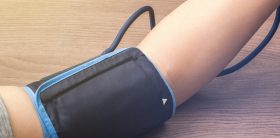Many people with type 2 diabetes have high blood pressure – also called 'hypertension'. We give you the facts about what it is and why it matters, together with tips to manage high blood pressure. All the information you need is right here!
What exactly is high blood pressure?
Everyone has blood pressure. It’s the force of blood on the arteries, as it moves through the body, carrying oxygen and nutrients. When this force is too great, it is called high blood pressure, or hypertension.
High blood pressure can damage your arteries and puts harmful pressure on many vital parts of the body. This adds to the risk of complications like heart disease and stroke, and eye and kidney disease.
Since people with diabetes already have a high risk of these complications, it’s important to understand how to manage high blood pressure and cut the risk.
How to get blood pressure back to normal
The recommended blood pressure target for someone with diabetes is less than 130/80. If you have been told you have high blood pressure, one or both of these numbers are higher than this. It’s time to take steps to manage it!
Medications will usually be prescribed to start bringing blood pressure down. Don’t be surprised if you are advised to take two or even three different types. Blood pressure medications often need to be combined with others to work most effectively. They also often take up to six weeks to work, so be patient!
In addition to medications, there are other important steps you can take to make a big difference and bring your blood pressure down.
Get off the couch!
Physical activity is one of the fastest ways to start bringing blood pressure down. Many people can literally see the numbers going down if their blood pressure is monitored when they are on a treadmill. You can get the same effect through a brisk walk around the block or a bike ride.
The recommended amount of physical activity for people with diabetes is 150 minutes of moderate-to-vigorous-intensity aerobic physical activity per week. That’s about 20 minutes a day. The guidelines also recommend resistance exercise at least three times a week. But don’t be overwhelmed by the numbers. Any activity is better than no activity.
Watch your weight
If you are overweight, losing 10 pounds can bring your blood pressure down. Talk to the dietitian on your health care team about a weight management plan. This will likely include both dietary and physical activity recommendations.
You may also find it useful to read our article Making sense of well-known diets.
Choose healthy foods
Eat healthy foods more often. These include vegetables and fruits, whole grain foods, fish, lean meat and poultry, and low-fat dairy products.
Cut back on processed and fatty foods. Use olive oil or canola oil instead of palm or coconut oil or lard or shortening. For lots of helpful information and tips, watch our video Healthy eating for people with diabetes.
Cut back on salt
High sodium intake raises blood pressure. Take the salt shaker off the table and avoid salty foods like canned soups, cold cuts, pickles, soy sauce, salted chips etc, and processed foods. Fast-foods are also usually very high in sodium.
For tips to help reduce your sodium intake, see our expert dietitian’s blog article Shake the salt habit and lower blood pressure.
Quit smoking
Quitting smoking is important to reduce the risk of complications like heart attack and stroke. Talk to a member of your diabetes health care team about the best way for you to quit. There are a number of different options for you to consider.
Drink in moderation only
Avoid drinking more than one or two standard drinks a day. The recommended weekly maximum is 9 for women and 14 for men. Learn more about alcohol and the diabetes diet.
Have regular blood pressure checks
High blood pressure usually has no symptoms. Make sure you have your blood pressure checked regularly by your health care professional. Many pharmacies also have blood pressure kiosks where you can check your blood pressure.
 Diabetes Care Community Learn, connect and care
Diabetes Care Community Learn, connect and care





